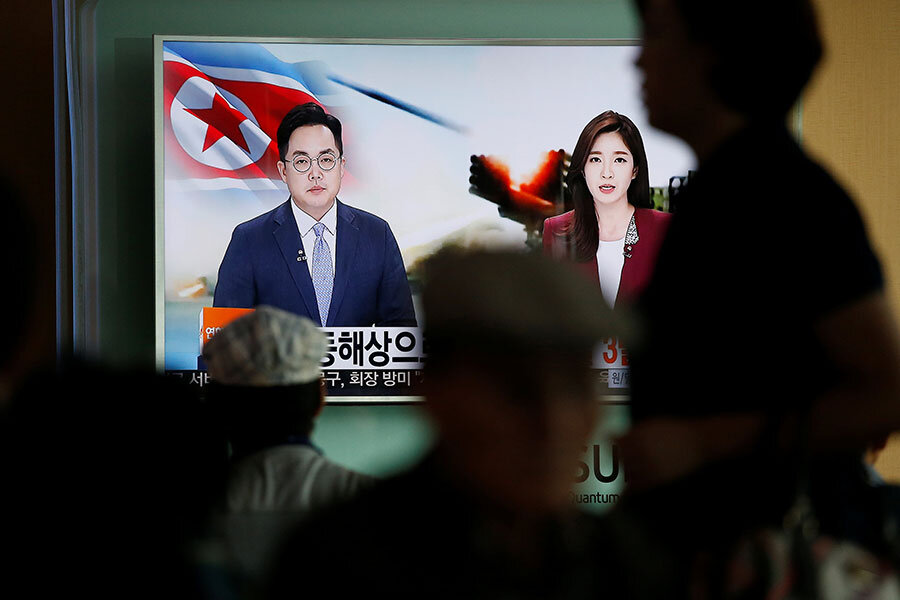What message North Korea missile launch really sends
Loading...
| Washington
As President Obama awoke in China Monday to the news that North Korea had launched three missiles overnight into the Sea of Japan, perhaps he was inclined to pick up a pen and jot down a little reminder.
“Note to successor: Worrisome steady progress on missile systems means ignoring North Korea won’t work much longer.”
That North Korean leader Kim-Jong un would choose to conduct a provocative missile launch this weekend was a foregone conclusion for many North Korean analysts.
Not only are world leaders in Hangzhou, China, for a G20 summit. But China’s President Xi Jinping sat down Monday with South Korean President Park Geun-hye, Pyongyang’s chief enemy. Moreover, the United States recently agreed to deploy the THAAD missile defense system in South Korea, a move that both China and Russia have criticized.
But what stood out about the launch early Monday was how it demonstrated the North’s steady progress in developing its missile systems targeting neighbors (and United States allies) like Japan and South Korea, US military forces in the region, and even to some extent the continental US. That progress was also displayed last month by the North’s launch of submarine-based missiles.
These steady technological advancements – in areas specifically barred by international actions – underscore how the threat posed by the North has intensified even as world powers have largely focused their attention elsewhere, Northeast Asia experts say.
“All I can say about North Korea is that no president has handed to his successor a better situation on North Korea than they inherited, because North Korea just keeps blowing through every agreement,” says Michael Green, a former director for Asian Affairs at the National Security Council under President George W. Bush and now an Asia analyst at the Center for Strategic and International Security Studies (CSIS) in Washington.
South Korean military officials said the weapons launched Monday were probably mid-range Rodong missiles, which flew about 600 miles west before crashing into the Sea of Japan within Japan’s Air Defense Identification Zone. Pyongyang gave no notification of the launch.
Japanese, South Korean concerns
Japanese officials condemned the launch and noted the North’s steady progress.
“Looking at the fact that the three missiles have landed on almost the same spot at almost the same time, I think their missile technology has substantially improved,” said Japan’s Defense Minister Tomomi Inada.
In past years, the North’s weaponry tests were characterized by failure, including missiles exploding in mid-air or wobbling and crashing well short of presumed targets. But more recent tests suggest North Korea is steadily learning from what appears to be a test-and-improve approach, Ms. Tomomi said.
The submarine-based ballistic missile launch last month prompted even sharper expressions of concern. Submarine-based missiles could potentially put more of South Korea and Japan within the North’s missile range and are harder than land-based missiles to detect before launch.
“North Korea’s nuclear and missile threats are not imaginary threats any longer, but they are now becoming real threats,” South Korea’s President Park said after the submarine launch. “Those threats are coming closer each moment.”
She cited the growing threats as justification for deployment of the THAAD (Terminal High Altitude Area Defense) missile-defense system.
The North does not yet have a functioning long-range missile capable of reaching the continental US, regional security analysts say. But they point to a mid-range ballistic missile test in June as evidence of a steadily advancing ability to reach US forces stationed in the region.
Ignoring warnings
So far, Pyongyang has shown no signs of heeding the international community’s warnings and punishments. After the United Nations Security Council in March unanimously approved perhaps the toughest set of punitive measures imposed on the North in two decades, the North appeared to ramp up its missile tests.
In August, Pyongyang confirmed what nuclear experts had speculated for months – that it had resumed production of plutonium at its Yongbyon nuclear complex. North Korea had agreed in 2007 to suspend activity there.
After the submarine-based launch, the Security Council called on UN member states to “redouble their efforts” to implement all UN sanctions imposed on the North.
The next president might face a similar urgency to go beyond simply taking note of North Korea’s progress in developing destabilizing weapons systems.








